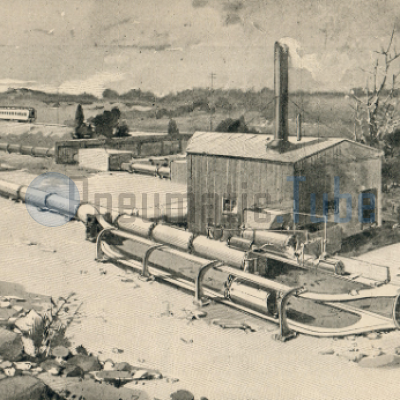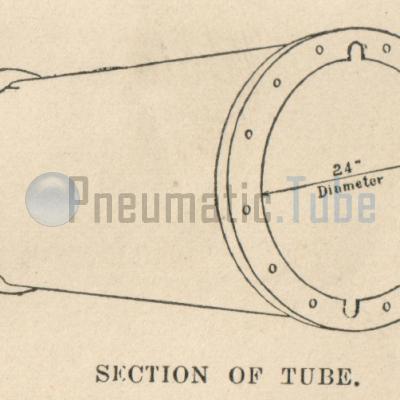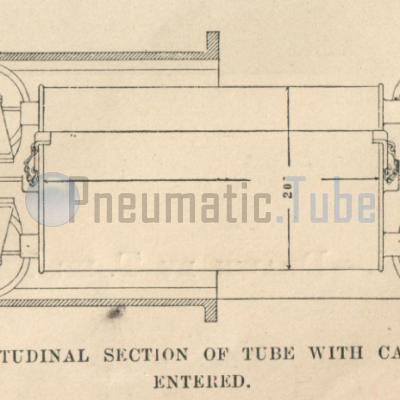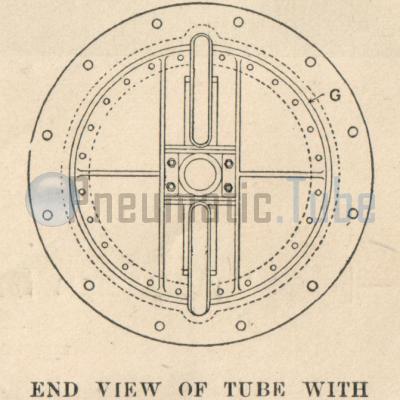Exhibition plant of pneumatic tube in operation at Burlington, New Jersey
Found in the Harper's Weekly, A Journal of Civilization (American political magazine based in New York City) of Saturday August 8, 1896. Written by Barnet Phillips.
The pictures associated with this article can be found below the text.
WHY SHOULD THE MAIL SERVICE IN CITIES BE SO SLOW?
THE PNEUMATIC-TUBE SYSTEM.
The postal service of the United States is in a measure accountable for the length of time taken in the preliminary forwarding of mail matter. No possible fault can be found with the general expedition. Postal trains running at the highest rate of speed carry the mails. Methods of handling large masses of matter are marvelous for celerity. Nevertheless there are in all the great centers of population delays more or less vexatious in the starting of mail matter.
The perfect postal service is really nothing more than an express business. ???? the assurance of the perfect safety of the object r????d and delivered, it is the element of speed which ????amount, but the entire system of post-office is ????fault so far as relates to the initial movement of mail matter in the large cities. It is not synchronous. A letter is mailed from New York to Chicago. Once put in the mail-car it tears along at the rate of say forty-five miles an hour until it reaches its destination. But why should that same letter on its way from the General Post-Office in New York to the Forty-second Street depot, during its first transit, take at the very least forty minutes to go over an insignificant 3.23 miles? Or as much time again on arrival at Chicago? There are, then, always two delays.
In the endeavor to become familiar with the many conditions of the initial movement of mail matter in the leading cities, a series of questions was addresses to postmasters, and the following answers were received. To the query, "Distance in miles from your main office to the principal railroad depot to which you send, or from which you receive, the largest portion of your mail matter?" The answers received were: In New York the distance was 3.23 miles; time occupied, 40 minutes. For Philadelphia, .68 of a mile; time, 10 minutes. In Chicago, 1.3 miles; time, 30 minutes. In Brooklyn there were two distances, the one 1.63 and the other 3.60 miles, the time being 27 and 35 minutes. Should there be a fog in the East or North River during the water transportation of the Brooklyn mail, several hours might lapse before a landing could be made. In Boston, there being four railroad stations with 74/100, 62/100, 89/100 and 53/100 of a mile, the time varies from 20 to 25 minutes. In St. Louis the distance was 1.18 miles; the time, 15 minutes. In Baltimore, 1 1/4 miles, and the time, 25 minutes. The variations in the time are due too the accidents of position, but invariably the larger the city the longer is the time required.
Such alleviations as have been brought about by the Post-office Department by the use of surface roads are most worthy of praise, but in the large cities obstructions to rapidly of movement must be constant. Streets are being continually. When there is a heavy snow-storm all the roads leading from depots to post-offices, or in the opposite direction, are for a time impracticable. In New York the difficulties of sending or receiving mail matter within its own limits are always increasing. When there is a Greater New York, or an enlarged Chicago, the trouble just ever go on in an augmenting quantity. Why should there not be, not one or two, but three or four daily deliveries of the letters written in New York and addressed to New York?
Branch offices in all the great cities are necessities, and there will be always increasing in number. The question having been asked of postmasters as to the number of their branch offices and the total distances from the main central office, a summary of the replies is as follows:
Branch
offices.
No.Total distance to
branch offices.
MilesIn New York . . . 24 155.22 In Philadelphia . . . 37 187.02 In Chicago . . . 40 322.99 In Brooklyn . . . 16 80.42 In Boston . . . 21 79.00 In St. Louis . . . 23 35.00 In Baltimore . . . 31 195.08 As to the time necessary to send a mail-bag from any central office to a branch office, the data, if available, would be valueless. They would vary according to conditions. In certain cases a letter carried 100 miles by railroad within three hours arrives at a city, plus the time necessary to transport it to and from the main office by wagon. Then the letter may have to go by wagon to a branch office. Sometimes this additional say five miles occupies a time represented by an hour and a half. The railroad has carried the letter at a speed of 33 1/3 miles an hour, while the wagon or other method of transportation has gone at the rate of 3 1/3 miles in the hour. Then the average speed of the letter over a total distance of 105 miles is only 23.333 miles per hour, and that is very slow time indeed. When many tons of mail matter must be forwarded, it is in overcoming the vis inertiae at the beginnings, twice occurring, that the main difficulty lies.
This bulk of mailable matter, unless all the wheels of commerce be blocked, will go on augmenting and augmenting, and particularly in the large cities, because they are the centres of receipts and deliveries, and it makes no matter whether they are on the seaboard, as is New York, or central, as is Chicago. The following statistics show this. In New York, during 1890, the daily weight of mailable matter was 332 tons. In 1885 it was 486 tons. In Philadelphia the increase is ten per cent. In Chicago the increase has gone with leaps and bounds, and for a certain class of matter has sword an increase of thirty per cent. In Boston, eight and a half per cent. In St. Louis, sixteen per cent., and with a notable augmentation in Baltimore.
As to the cost of the initial movement of the mailable matter, that varies, and the exact figures are obtainable from the Postmaster-General. It must amount to a good round sum. For instance, the service between New York and Brooklyn is carried on by wagons, making thirty-six trips daily. Its speed is fair, but it never can be rapid enough to suffice for the wants of letter communication between two great cities; and exactly similar conditions exists in St. Louis, and are particularly emphasized in Chicago.
Considered, then, in its proper light, this city transportation of mail matter is distinctly behind the age, and belongs to the first half of the present century. Nothing herein is even intimated as to the safety of such conveyance of mail by wagons or surface cars. It is exceptional whereby robbery is brought to light. But the main factor of the postal system being speed, all city movement of mail is provokingly slow; and, what is worse, in the time to come, when there will be more material to be sent and more chances of streets being blocked, this movement will be even more snail-paced.
On a meadow near Burlington, New Jersey, there is stretched along for the distance of half a mile a line of connected iron tubing. These tubes are made at a neighboring foundry. With the exception that they have two grooves cast in them they are nothing but common water mains. The tubes are just as they came from from the foundry. Like all such piping, requiring connecting so as to withstand ordinary water pressure, the tubes have been faced at the ends, and are secured with nuts and bolts, a slight coating of litharge or white-lead having been applied, as is usual, to the squared surfaces.
Referring to the illustration above, it will be seen that there is a double line if piping running parallel, and at the turn the curve is a sudden one. A diagram below gives the diameter of the tube with its grooves, which is twenty-four inches. The entire plant and the method of work can be at once understood. The is a small engine, which runs a blower of no extraordinary size or uncommon pattern. The motive power, placed in a temporary house, in an ordinary engine of not more than twenty horse-power. The carrier, or the wagon, is shown in another diagram in its longitudinal section, just as it is placed in the tube. This carrier is a circular metal box, of sheet-iron or of bronze. It runs on four wheels, two of which are above and two below. The wheels are mounted on pivots, which have a free lateral movement; of these four wheels, two of them follow the upper groove, two the lower groove. The engine is set in motion, the fan revolves, and the air at the start is received in a short cast-iron tube and stored. As soon as a sufficient pressure is reached, a comparatively low one of sixty pounds, taking hardly any time, the carrier is set by hand in the tube, the wheels adjusted to the grooves, the air is let on, and away travels the carrier along the tube, around the curve, and comes out at the exit or terminal.
Starting at one or the other side of the engine-house, according to where it is placed, the carrier makes the entire circuit. Now as to the speed. The half-mile is made in fifty seconds, then the whole mile would be made in a minute and forty seconds. For all practical purposes the carrier moves at the speed of thirty-three miles an hour. This speed is not a maximum but a minimum one, for the absolute air pressure on the carrier is only six ounces to the square inch. Very much faster time could be imparted by an increased air pressure.
It can be understood that for the return trip of the carrier all that has to be done is to reverse the direction of the blower. The carrier is then sucked through the line of tubing, and so arrives at the terminal from whence it my have first started.
In a series of workings made for the writer, carriers were repeatedly sent forwards and backwards, all arriving safely at their destination and at the rate of speed indicated. There was a little sound of in rushing air at the start, a long rumble, and then in I a short time, a little over the half-minute, there was the carrier, quietly landed.
The carriers used were of sheet-iron, and would weigh 450 pounds. New carriers, of bronze, which would be lighter to handle, are to be substituted; but the heavy iron ones worked perfectly. In the carrier there would be placed the mail-bags, many of them, the length of the carrier being 3 feet and diameter 22 inches. These carriers are closed by means of two locks and keys, so that they could be only opened by the proper post-office officials.
As to the matter of speed, that being settled, then comes the question of the continuous movement of the carriers. If there were long intervals of time necessary between the sending of one carrier and the next one, the rapid movement of a single carrier would not suffice. The question of continuous service presents no difficulty. Just as fast as a carrier could be put into the tube it went on its way, to be followed by other carriers, and all of them traveled along at the same rate of speed, and were delivered seriatim at the terminals, and without interference. The method of pneumatic transmission makes an air cushion between any two carriers, so that telescoping seems to be impossible. In front and back of each carrier there is a shield of rubber. There might, however, be another danger. If the carrier and its load, the mail-bags, were “fired,” like Captain Zalinsky’s shells, from a pneumatic gun, and the carrier with the letters shot into the air, or ejected parallel with the ground at the terminals, the contents might be torn to atoms. To guard against such contingencies there is the simplest of devices. As the carrier approaches its terminal, say at the distance of fifty feet, there is a gate which holds in the air. As the carrier nears its terminal the speed is naturally diminished. The air acts like a brake. When quite near the end, by an automatic movement, imparted by the carrier, the gate opens. The carrier then is delivered slowly - its impetus is gone. It just speed enough to roll its way leisurely along an open tramway which has a slight grade, and then it comes to rest in a tube where there is a cushion. This is shown particularly in the illustration.
How is switching carrier out? The carrier would be required to deliver its mail-bags at various railroad deports or branch post-offices. Any one who has seen the type-setting machinery of to-day can at once appreciate what is exactness of automatic movement, and how the many types are switched off, each one findings its own particular receptacle. The carriers have each its individuality, and will change direction automatically, moving to the right or the left of the main tube and passing along a side line. Many trails were made in switching carriers on the pipe-line, and there were no wrong deliveries. Close to the fence in the illustration, on the tube to the right, there may be seen a square form; this is one of the switch-boxes, and the carrier is shunted off here and traveled through a distinct tube, which is shown to the extreme right.
As to the size of the tubes, twenty-four inches, this could be notable increased did the exigencies of any large mail service require it. It would not be a question of strength of iron tube, but increase of air pressure.
In working the passage of the carriers hardly any precautions were necessary. As to the plant itself, the tubing had been exposed through the winter to the cold and during this spring to the heat, and no measures had been taken to protect it. There might have been expansion, contraction, or deflection, but that seemed to make to make no difference. The apparatus worked at once, without a hitch, and required no special skill.
There will always will be accidents in ant mechanical system, as like to occur to a watch as to the engine of a transatlantic steamer. If, then, a carrier should come to grief, or stick, say, from a broken wheel, just where the accident happened can be indicated by a common and well-known electrical device. Then again the tubes are large enough for human exploration. There is nothing new in pneumatic propulsion. It is centuries old. For the transmission of mail-matter, however, plans before this have been little more that toys, and complicated at that. They were impracticable for the carrying on of the vast business of great post-office centres as they exist to-day in New York, Philadelphia, and Chicago. It is the simplicity, the inexpensive character, of this Burlington plant which is remarkable. As to the mounting of grades, even steep ones, with this system, such difficulties need barely be noticed.
Supposing, then, that from the main post-office in New York City such a pipe-line were laid to the Forty-second Street depot. Within four minutes there would be service between these two point. It could be worked to all the depots and branch offices. The letter written by one New-Yorker and addressed to another New-Yorker, no matter how far distant within the city, would certainly reach him within a couple of hours, the time of the longest hand delivery being added. There could be three or four of such local deliveries in every ten hours, and as many answers given.
The initial movement of mail matter in our large cities is lamentably behind that of London, Paris, Berlin, or Vienna, for in most of these capitals there is a partial transmission of the mails by means of pneumatic tubes. It has been noted that in no country is the man whose business it is to carry or collect or sort the mail of so high an order of intelligence as the one attached to the United States Post-office Department, but the machinery to add to his efficiency is inadequate at the very start.
The author of the article is Barnett Phillips, the artist of the drawings is unknown. Since both are published far more than 70 years ago, they are believed to be in the Public Domain.
 Pneumatic Tube, Rohrpost, Buizenpost
Pneumatic Tube, Rohrpost, Buizenpost
Exhibition plant of pneumatic tube in operation at Burlington, New Jersey
Published: 08-04-2021
Last updated: 12-05-2021
Show related articles:
Pneumatic Tube Calendar
24 October 1864 (161 years ago)
Commissioning Pneumatic Tube Mail Hamburg, Germany
31 October 1874 (150 years ago)
Pneumatic Tube Mail railway in London, Great Britain out of business
1 October 1879 (146 years ago)
The Mix & Genest company was founded by the businessman Wilhelm Mix and the engineer Werner Genest in Berlin-Schöneberg
7 October 1897 (128 years ago)
Commissioning Pneumatic Tube Mail New York USA



